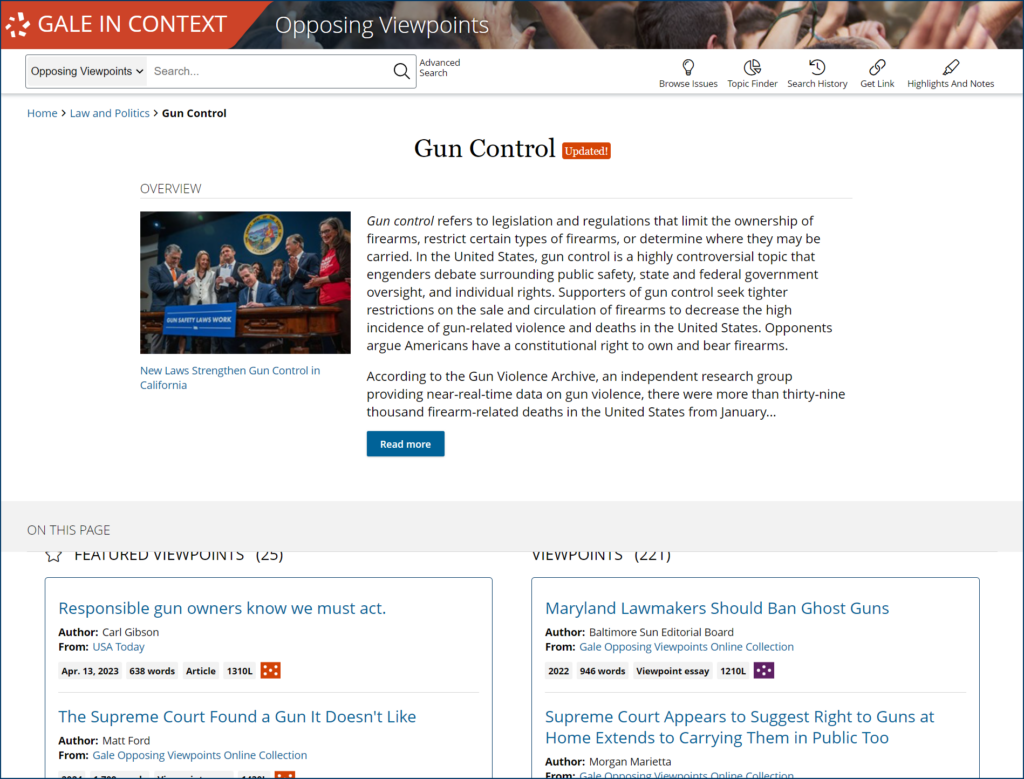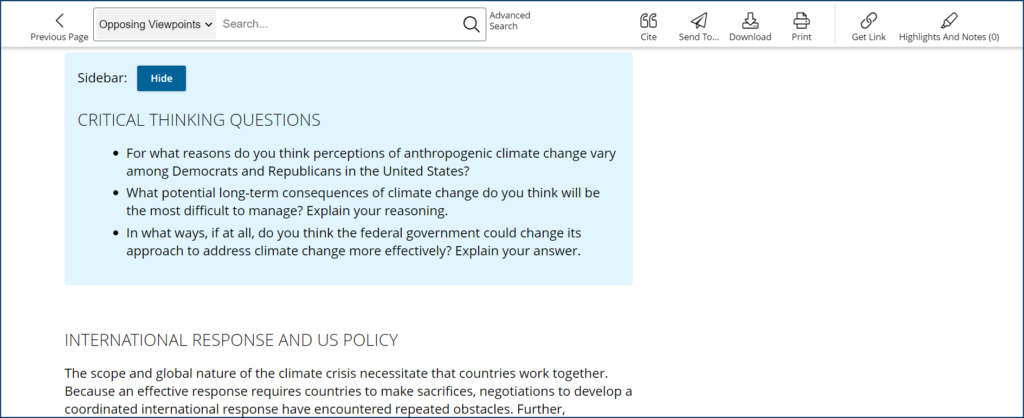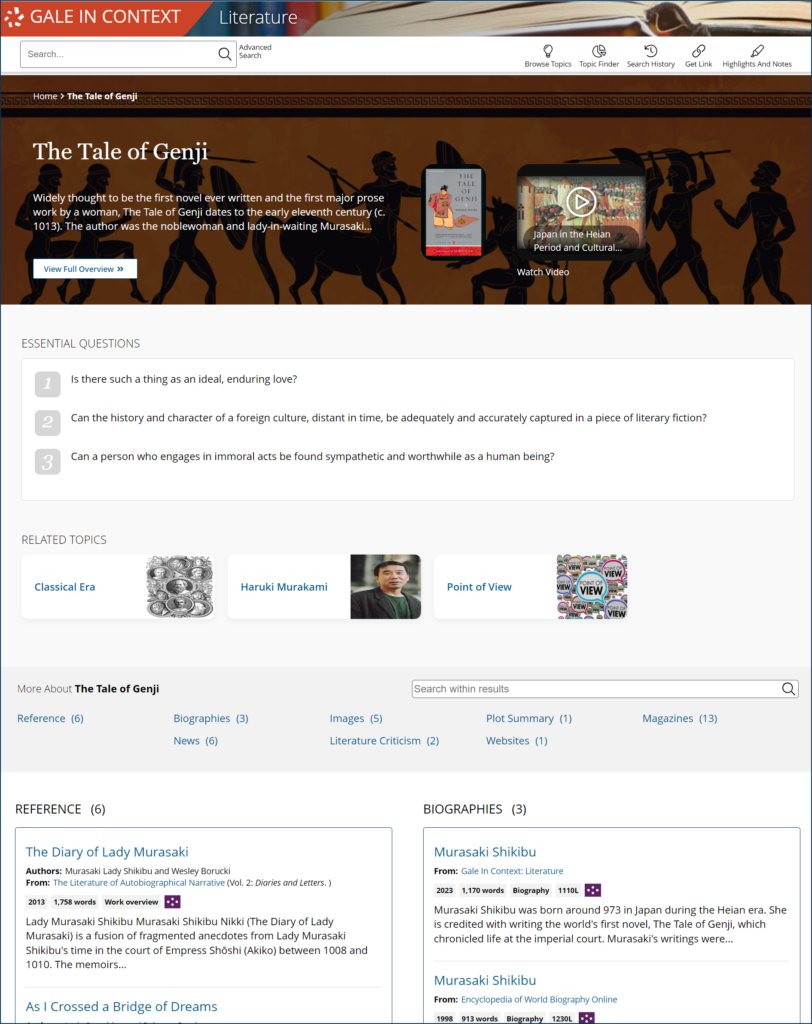What does lesson planning look like for you?
If you’re like many educators, it consists of carefully evaluating resource after resource, hand-selecting the best material, and figuring out a way to weave it all together into a logical, organized flow. You spend time scrubbing through YouTube videos to check for inappropriate language, creating text sets that cover the same topics while meeting the needs of all Lexile levels, creating assessments that inform where you’ll pivot next, and so on, ad nauseam.
While it’s an admirable method for ensuring your students access engaging, exciting content, it’s also time consuming. When you take a step back, it makes sense why K-12 teachers rank as the profession with the highest burnout rate at 44 percent.1
Instead of doing the heavy lifting of curating content for your students, reclaim your lesson-planning hours for yourself and make Gale In Context your classroom’s everyday go-to resource for everything from daily bell ringers to multimedia materials that bring learning to life.
1. Spark Discussion and Debate with Irresistible Bell Ringers
When your students walk into your classroom, there’s no telling what’s on their minds, how ready they are to learn, or whether they’ll deem today’s class worthy of their time. Bell ringers—particularly ones that spark students’ urge to discuss or disagree—are the great equalizer to get every learner focused on the same task while whetting their appetite for today’s topic. They’re also a powerful tool for teaching students to speak up and advocate for their opinions with compelling evidence, a skill essential for becoming informed citizens and inspiring them to make meaningful contributions to the world.
Instead of spending your energy trying to verbally spark their interest, shake up your bell ringer routine by presenting a controversial topic, they won’t be able to help but have an opinion on.
Throughout the rest of your unit, allow students to explore the arguments and evidence for both sides of the debate using Gale In Context: Opposing Viewpoints and evolve their answers as they learn more. By the end of the unit, they’ll have a robust, tangible record of their learning and a self-made resource to use during a summative assessment that asks them to answer the original bell ringer in a more formal, argumentative essay.
2. Encourage and Develop Student-Led Inquiry with Built-in Guidance
When teachers send students to the open web to dig into a topic independently, there are certain risks involved. The accuracy and appropriateness of content can’t be guaranteed. While one option for teachers is to painstakingly curate resources for students to use, that can take away a student’s sense of ownership and shut the door to students discovering something meaningful that you hadn’t yet considered.
Gale In Context topic pages bring the best of both worlds to your classroom while providing depth and diversity that students wouldn’t likely encounter through an unguided internet search. Sure, a quick web search is a convenient and familiar choice, but it can’t compete with the credibility of a Gale In Context topic page. Each topic page is loaded with a curated collection of trustworthy resources across a range of genres and formats, including historical documents, educator-vetted websites, newspaper articles, academic journals, images, and more.
Every topic page also features three essential questions designed to lead students to engage critically with the content they’re learning. Let them select one of the three essential questions as a writing prompt. In doing so, you’re giving students voice and choice by letting them focus on the prompt they connect with most and deciding which resources they value for supporting their argument.
3. Create Stronger Cross-Curricular Connections with Ease
Cross-curricular connections provide a more tangible answer to the question “When am I going to need to know this in real life?” by breaking down the silos of traditional subject boundaries while equipping students with the skills they need to think critically about the world they live in.
With Gale In Context, you can leverage the social studies resources available in U.S. History, World History, and Global Issues databases to give students historical context and a sense of perspective while reading a text in English language arts class. At the same time, history lessons come to life in narrative form with Gale In Context: Literature as students engage with and analyze characters’ motivations, aspirations, and actions based on the predominant sociocultural climate in that period.
Pair texts like The Tale of Genji with modern pieces about the history of samurai in the Heian period and use it as a springboard to discuss why the author, Murasaki Shikibu, may have chosen the traits she did for the romanticized titular character. Better yet, let your students guide the topics you discuss as you move through the novel, and rest assured that you’ll be able to find appropriate resources on the fly, with no need to scour through web searches.
4. Enjoy Working Smarter with Gale In Context: For Educators
Lesson planning is hard.
Educators are asked to engage learners with interactive, student-led learning opportunities while adhering to rigorous standards, providing formative assessments, and differentiating each activity based on the specific needs of every individual. Teachers need—and deserve—the support Gale In Context: For Educators offers.
Gale In Context: For Educators provides a platform that empowers educators to reclaim their time with ready-to-use, standards-aligned lesson plans across diverse topics, embedded formative assessments with content, and tools for building text sets using resources from across the Gale In Context suite.
Are you ready to improve the education experience and equip and inspire students for lifelong learning? Reach out to your Gale representative to discover more.
1. Stephanie Marken and Sangeeta Agrawal, “K-12 Workers Have Highest Burnout Rate in U.S.,” Gallup, June 13, 2022.




